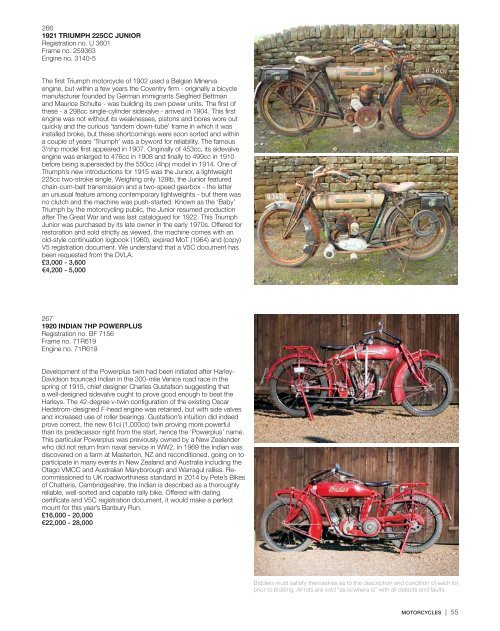S-22720-0-1
S-22720-0-1
S-22720-0-1
- No tags were found...
You also want an ePaper? Increase the reach of your titles
YUMPU automatically turns print PDFs into web optimized ePapers that Google loves.
2661921 Triumph 225cc JuniorRegistration no. U 3601Frame no. 259363Engine no. 3140-5The first Triumph motorcycle of 1902 used a Belgian Minervaengine, but within a few years the Coventry firm - originally a bicyclemanufacturer founded by German immigrants Siegfried Bettmanand Maurice Schulte - was building its own power units. The first ofthese - a 298cc single-cylinder sidevalve - arrived in 1904. This firstengine was not without its weaknesses, pistons and bores wore outquickly and the curious ‘tandem down-tube’ frame in which it wasinstalled broke, but these shortcomings were soon sorted and withina couple of years ‘Triumph’ was a byword for reliability. The famous3½hp model first appeared in 1907. Originally of 453cc, its sidevalveengine was enlarged to 476cc in 1908 and finally to 499cc in 1910before being superseded by the 550cc (4hp) model in 1914. One ofTriumph’s new introductions for 1915 was the Junior, a lightweight225cc two-stroke single. Weighing only 129lb, the Junior featuredchain-cum-belt transmission and a two-speed gearbox - the latteran unusual feature among contemporary lightweights - but there wasno clutch and the machine was push-started. Known as the ‘Baby’Triumph by the motorcycling public, the Junior resumed productionafter The Great War and was last catalogued for 1922. This TriumphJunior was purchased by its late owner in the early 1970s. Offered forrestoration and sold strictly as viewed, the machine comes with anold-style continuation logbook (1960), expired MoT (1964) and (copy)V5 registration document. We understand that a V5C document hasbeen requested from the DVLA.£3,000 - 3,600€4,200 - 5,0002671920 Indian 7hp PowerplusRegistration no. BF 7156Frame no. 71R619Engine no. 71R619Development of the Powerplus twin had been initiated after Harley-Davidson trounced Indian in the 300-mile Venice road race in thespring of 1915, chief designer Charles Gustafson suggesting thata well-designed sidevalve ought to prove good enough to beat theHarleys. The 42-degree v-twin configuration of the existing OscarHedstrom-designed F-head engine was retained, but with side valvesand increased use of roller bearings. Gustafson’s intuition did indeedprove correct, the new 61ci (1,000cc) twin proving more powerfulthan its predecessor right from the start, hence the ‘Powerplus’ name.This particular Powerplus was previously owned by a New Zealanderwho did not return from naval service in WW2. In 1969 the Indian wasdiscovered on a farm at Masterton, NZ and reconditioned, going on toparticipate in many events in New Zealand and Australia including theOtago VMCC and Australian Maryborough and Warragul rallies. Recommissionedto UK roadworthiness standard in 2014 by Pete’s Bikesof Chatteris, Cambridgeshire, the Indian is described as a thoroughlyreliable, well-sorted and capable rally bike. Offered with datingcertificate and V5C registration document, it would make a perfectmount for this year’s Banbury Run.£16,000 - 20,000€22,000 - 28,000Bidders must satisfy themselves as to the description and condition of each lotprior to bidding. All lots are sold “as is/where is” with all defects and faults.motorcycles | 55


